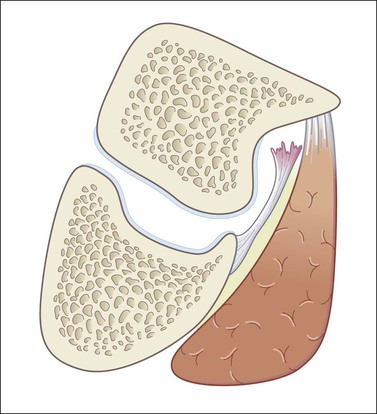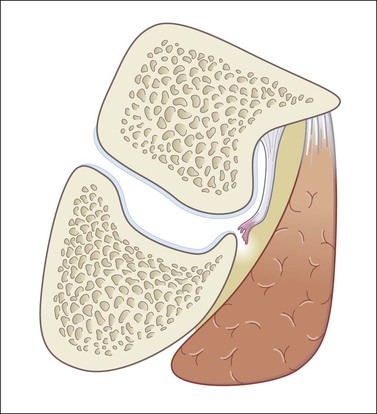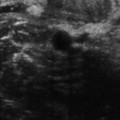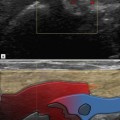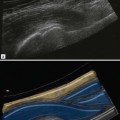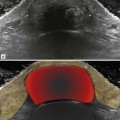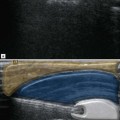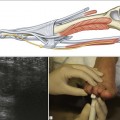Disorders of the Elbow
Medial
Common Flexor Origin Enthesopathy
Pain is worse on resisted flexion, as opposed to extension with common extensor origin (CEO) tendinopathy.
The musculotendinous junction is more proximal so the overall ultrasound appearance is of a more muscular or fleshy appearance compared with the CEO (Fig. 7.1).
This more general hyporeflectivity must not be misinterpreted as tendinopathy. Signs of tendinopathy include loss of the normal fibrillar structure of the true tendinous portion of the CFO. Increased Doppler is a common and useful sign to draw attention to the diseased area. More advanced signs include tendon delamination leading to partial tears and ultimately tendon separation from the epiphysis (Fig. 7.2). Acute changes, particularly due to trauma, may also involve the pronator teres muscle. Chronic changes include calcification and bony irregularity representing enthesopathy at the attachment.
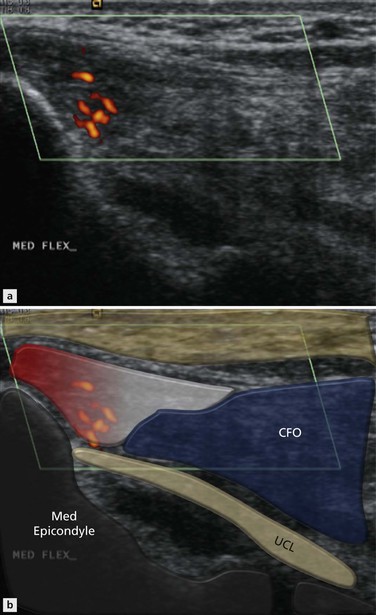
Figure 7.1 Coronal image of the medial elbow. There is loss of reflectivity and increased Doppler activity in the proximal part of the CFO consistent with epicondylitis.
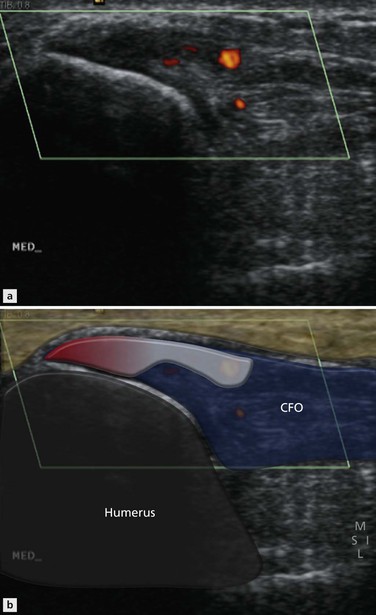
Figure 7.2 Coronal image of medial elbow. Further example of epicondylitis with disordered reflectivity and increased Doppler.
There is a close association between CFO tendinopathy and ulnar neuritis, and in many patients the symptoms overlap.
Ulnar Collateral Ligament
There has been considerable study of the biomechanics of throwing, particularly in North America where throwing sports play such an important role in late childhood and adolescence. The overhead throwing sequence is divided into a number of phases, with stress being placed on different structures in each phase. The phases are an initial wind-up, early and late cocking, early and late acceleration, deceleration and follow through. Poor technique tends to lead to increased valgus forces, which in turn lead to tension along the ulnar aspect of the elbow.
Stress on the UCL is greatest in the late cocking phase. Tears of the UCL, shearing between the posteromedial olecranon and adjacent posterior aspect medial epicondyle, and compression at the radiocapitellar joint may all follow.
Injuries to the UCL include complete and partial rupture. Complete rupture is easier to diagnose than partial injuries. Complete rupture may be proximal or distal, and partial rupture tends to be distal and may be limited to separation of the joint surface of the ligament from the sublime tubercle of the ulna (Figs 7.3, 7.4 and 7.5). Plain films are rarely helpful, although they can occasionally identify an enthesophyte. Ultrasound and MRI are both used, and MRI arthrography is superior to MRI for subtle injuries.
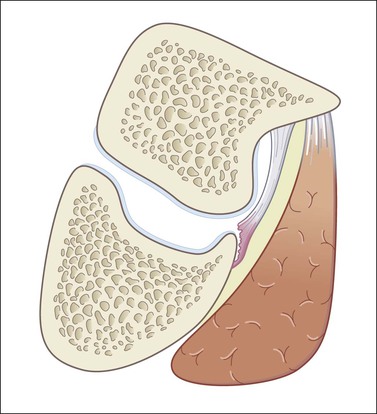
Figure 7.5 Schematic diagram of the partial tear of the distal ulnar collateral ligament attachment. The ligament is lifted from the underlying sublime tubercle allowing joint fluid or contrast to pass between it and the underlying ulna. Fluid pas above and below the line of fluid in the joint is referred to as the T-sign.
The ultrasound findings in UCL tear include disorganization of the normal fibrillary structure, increased size and laxity. In the acute phase free fluid may be seen to traverse the tear and exude from the joint into the surrounding soft tissues. Partial tears are more difficult to detect but in addition to disorganization of the ligament on ultrasound, focal pain is an important aspect of diagnosis.
Strain of the UCL may only manifest as ligament dysfunction and stressing the ligament is important to detect these more subtle injuries.
The methods for stressing the ligament have already been described in the techniques section.
Stay updated, free articles. Join our Telegram channel

Full access? Get Clinical Tree


